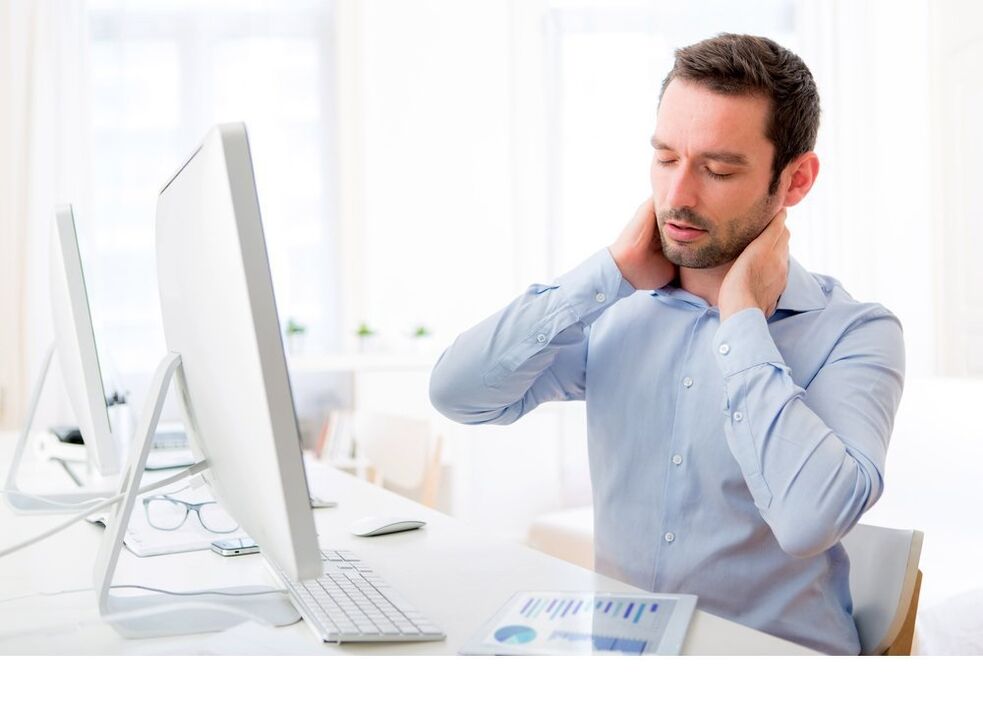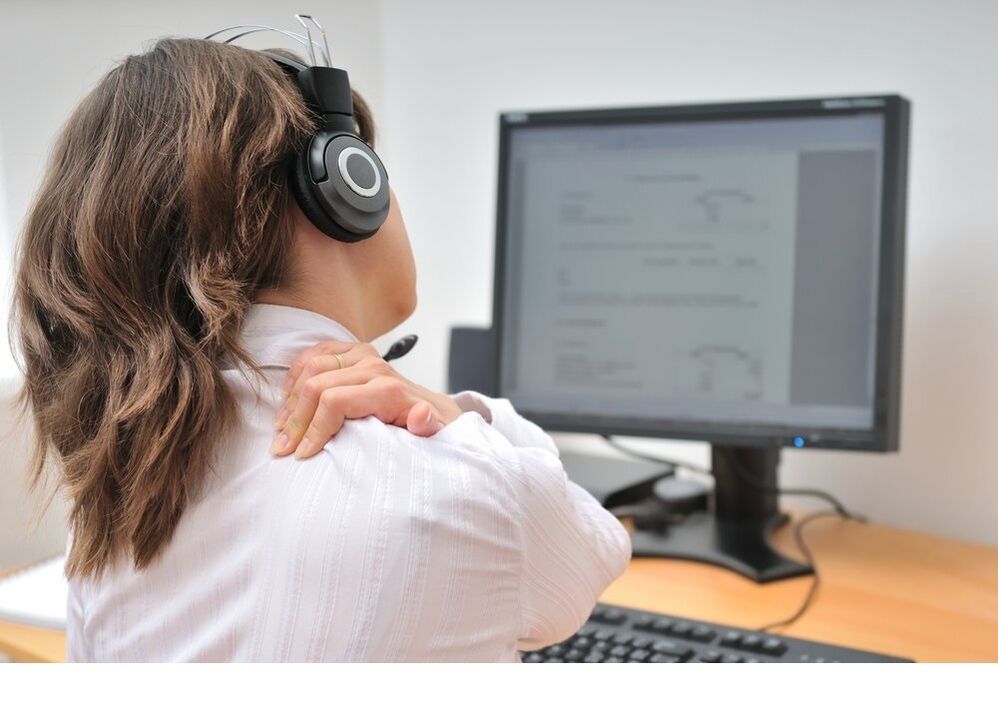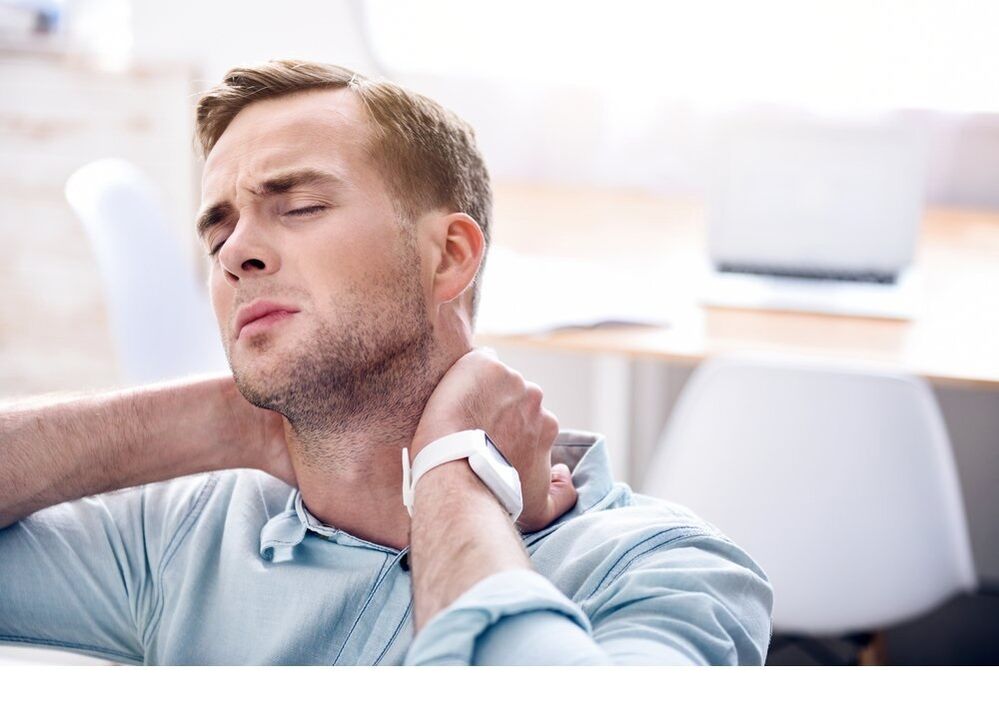The symptoms of a sore throat are familiar to everyone: it pulls on the muscles, it's impossible to tilt and turn your head, and to look to the side you have to turn your whole body. The culprit of problems, as a rule, is the spine: infractions, hernias, scoliosis lead to the person feeling pain in the back and neck. Discomfort makes him self-medicate. But if the pain radiating to the neck doesn't go away after home therapy, the next step is to visit the doctor.
Neck pain in adults
Neck pain in women

Neck pain during pregnancy
Back and neck pain often worries pregnant women. The explanation is simple - with a change in body weight and proportions, posture changes, spinal load increases.
How to deal with this nuisance? A special maternity bandage will help keep your back in the correct position. To strengthen the back and neck muscles, it is helpful to do swimming and yoga (of course, with the permission of an obstetrician-gynecologist). You need to sleep in a comfortable position, on a hard mattress and a low pillow. But the most important thing is to consult a doctor, as any self-medication can negatively affect the state of the mother and fetus.
Neck pain in young mothers
Back and neck pain is common among young mothers. The issue is complicated by the fact that a woman during breastfeeding cannot use many medications, because harmful substances will enter the milk. How can you help yourself and prevent pain in the neck region from interfering with the baby's joy?
- Monitor your posture. While carrying a child, the center of gravity shifted with an increase in the abdomen - you had to lean back to keep your balance and your shoulders were tense all the time.
- Don't physically push yourself too hard, try to properly distribute the load on your back. Various transport devices can help with this. They distribute the child's weight over both shoulders and prevent back and neck fatigue.
- Baby care items should be adjusted according to her height so she is not in an uncomfortable position for too long.
- It is very important to be in a comfortable position while breastfeeding, especially at night.
Neck pain in men

Neck pain, as a rule, does not differ by gender - it can appear in both men and women. And yet, there are some differences in anatomy: The male neck is decorated with a pronounced Adam's apple - a thickening of the thyroid cartilage, the plates of which are located at an angle to each other.
Adam's apple pain in men can indicate a very serious illness:
- Thyroiditis is an inflammation of the thyroid gland. With thyroiditis, patients are concerned about pain in the neck on turning, pain in the Adam's apple above and below it, swelling of the neck.
- Thyroid cartilage cancer - its danger lies in the fact that the onset of the disease can be similar to a common cold: sore throat when swallowing, it is difficult to turn the neck and even breathe.
- Thyroid cartilage phlegmon is a life-threatening, extensive suppuration of the cartilage and soft tissue of the neck. Patients complain of chills and high fever, pain on swallowing, loss of voice, difficulty breathing.
- Cartilage tuberculosis usually occurs with existing pulmonary tuberculosis and is its complication.
- Kadik may be ill due to osteochondrosis. Rape causes pain when swallowing, sneezing, coughing.
- Fractures, bruises, and cartilage compression can cause dislocation, neck swelling, and suffocation.
Neck pain in the elderly
Pain radiating to the neck in elderly people may indicate the development of diseases:
- Cancer of the apex of the lung (cancer with Pancost and Horner syndrome). The patient's pain, in this case, is associated with tumor growth in the nerve endings of the shoulder girdle and neck.
- Neck tumors, salivary glands.
- Coronary heart disease. The pain can spread from the chest to the neck and arms, causing symptoms similar to osteochondrosis.
- Polymyalgia rheumatica is an inflammatory disease characterized by stiffness and pain in the muscles of the shoulder girdle and hips.
- Spinal metastases in various cancer diseases (it's no secret that the probability of developing cancer increases with age).
- Cervical vertebra subluxation as a complication of rheumatoid arthritis.
- The most common causes of neck and neck pain in the elderly are osteoarthrosis and osteochondrosis of the spine, rheumatoid arthritis, and chronic inflammation of the connective tissue.
Neck pain in children

Severe neck pain in children occurs for the same reasons as in adults:
- Trauma
- osteochondrosis
- stress and anxiety
- tumors
- Diseases of other organs causing distant pain
Perhaps the most specific "infant" cause of neck pain is torticollis, when the child's head is turned sharply to the side. Torticollis is dangerous because it bends the cervical spine and interrupts the formation of the facial skeleton.
Contrary to popular belief, the disease doesn't just occur during childbirth. Depending on how the torticollis appeared, the following types are distinguished:
Torticollis (with the exception of dermatogenic and neurogenic) is usually seen in newborns or manifests itself in the first few months. The greatest risk of its occurrence arises when:
- The fetus during natural childbirth is in breech presentation.
- The location of the fetus in the mother's abdomen is such that the wall of the uterus puts pressure on the neck.
- Delivery is difficult and the baby's mastoid muscle is damaged (with scarring).
- It is necessary to use forceps and vacuum for difficult labors.
- The mastoid muscle is inflamed during intrauterine development, as a result of which muscle tissue has been replaced by fibrous tissue in the area of inflammation.
- The mastoid muscle is pathologically hypertrophied and shortened.
- With a cesarean.
How can you cure stiff neck?
- The conservative method is done with the help of a course in massage and physiotherapy, special orthopedic shaping of the baby's head, use of an orthopedic collar and gymnastic exercises.
- Operation - performed if conservative methods do not produce results. During the operation, the surgeon stretches the sternocleidomastoid muscle and straightens the child's head position.
Different Types of Neck Pain
acute pain in the neck

Why is there a sharp pain in the neck? There are two reasons:
- Trauma (fracture, blow, contusion).
- Violation of nerve endings - this is the case of osteochondrosis, intervertebral disc herniation, spinal canal compression.
Treatment for pain depends on the cause and includes:
- Prescription of pain medications.
- Muscle relaxants and antispasmodics to relieve muscle spasm.
- Immobilization (immobilization) of the cervical spine.
- Exercise therapy and physiotherapy.
Severe pain in the neck
Severe pain in the neck is always unpleasant. I would like to quickly find out why it hurts and recover. What are the causes of severe pain?
- Exacerbation of osteochondrosis, when an unsuccessful movement, rotation, or concussion of the body causes displacement of the vertebrae, infringement of an existing hernia, compression of the spinal nerves.
- Cervical radiculitis (inflammation and compression of the spinal roots).
- Cervicago - "lumbago" (severe and acute muscle spasm).
- After an injury, severe back and neck pain can occur.
Neck pain with osteochondrosis
Neck pain with osteochondrosis is very severe and gives the patient many unpleasant minutes. As a result of muscle spasm or the dislocation of the vertebrae between them, the arteries supplying the brain can be compressed or twisted. In more severe cases, this can lead to a condition similar to pre-stroke, when a person is dizzy, everything floats before their eyes, sometimes speech and vision are lost.
neck pain on the left

Left neck pain is a possible symptom of problems not only in the cervical spine but also outside of it. What can a person have if they have neck pain on the left side?
- Heart disease (heart attack, coronary artery disease, angina pectoris).
- Cancer of the upper left lung.
- Injuries.
- Tumor metastases from other organs to the nodules on the left side of the neck.
- Infectious inflammation of the lymph nodes (due to tonsillitis, ARVI, tonsillitis).
neck pain on the right
Neck pain on the right is an alarming symptom, but most of the time it is explained in a trite way: a person has osteochondrosis with all the consequences. These consequences include nerve compression, muscle spasms, intervertebral protrusion and hernia, vascular disorders.
But there are other causes of right neck pain:
- Biliary colic radiating to neck and shoulder.
- Cancer of the right apical lung with tumor invasion of the nerves located above.
- Bruises, injuries, fractures of the clavicle and vertebrae.
- Cervical spine tumors (metastases from other organs).
- If the pain is concentrated in the right front of the neck, it can also indicate heart problems (heart attack, coronary artery disease).
- Inflammation of the lymph nodes due to ARVI and sore throat.
neck and shoulder pain

Neck and shoulder pain is a classic sign of cervical osteochondrosis and its complications (infraction of hernia, nerves, spinal cord trunk). In addition, simultaneous pain in the neck and shoulders is a symptom of these diseases:
- Gallstone disease during an exacerbation, with biliary colic.
- Heart diseases.
- Arthrosis of the shoulder.
- Cervical plexitis is an inflammation of the large nerve nodules in the spinal nerves.
- Periarthritis of the shoulder and scapula - inflammation of the shoulder tendons and shoulder joint capsules.
- Myositis.
- Arthritis.
neck and back pain
Pain in the neck and lower back, as a rule, is a sign of disseminated osteochondrosis, which has invaded the entire spine. After all, it doesn't happen that posture in one part of the spine is good and in the other bad. In osteochondrosis, neck pain is mild when the disease is in remission and severe, painful if it gets worse. The exacerbation starts with a sharp pain in the neck and back with an unsuccessful turn, movement, and impact. It can be removed with the aid of medication prescribed by the doctor, rest, mild heat in the affected area, exercise therapy and physiotherapy.
neck and neck pain
Neck and neck pain is most often a symptom of commonplace cervical osteochondrosis - a dangerous but not fatal disease. But sometimes it indicates meningitis, and this disease poses a threat to human life. The causative agents of meningitis - bacteria and viruses - invade the brain and spinal cord and cause inflammation of their membranes.
Numbness, pain in the neck and back of the neck, stiffness of the occipital muscles, inability to simultaneously pull the head to the chest, bend the leg at the knee - all these are meningeal symptoms that will immediately alert the doctor. The treatment of a dangerous disease is carried out in a hospital,
In addition to meningitis and osteochondrosis, the cause of pain in the neck and neck can be injuries, occipital nerve neuralgia, hypertension, and muscle tension.
Causes and Symptoms of Neck Pain
Trauma

The cause of neck pain sometimes becomes an injury, due to which the cervical vertebrae are dislocated or broken, the spinal nerves are damaged. Injuries can occur due to accidents, falls, injuries, poor diving or sudden movement. Symptoms of neck injury include:
- Incorrect flexion of the neck, inability to turn the head, tension in the chest and neck muscles indicate a fracture of the lower vertebrae.
- Pain in the crown and back of the neck is an indicator that the first cervical vertebra is damaged.
- Edema and "bruises" can be the result of a neck injury.
- Neck pain when turning the head, shoulders, upper chest and headaches are a symptom of whiplash injury, which occurs due to alternating sharp flexion and extension of the neck (this can happen when the vehicle is braked suddenly) .
Neoplasms

An extremely dangerous cause of sore throat is a malignant neoplasm. How can be?
- Neck pain as a symptom of upper lung tumor. It sprouts bundles of nerves and blood vessels, which cause severe pain. A person may experience neck pain on the left or right depending on the location of the tumor.
- A symptom of pain in the neck sometimes indicates the development of lymphoma - cancer of the lymph nodes. Since many lymph nodes are concentrated in the neck, they grow as the disease progresses and it's hard not to notice. Other prominent signs of lymphoma are excessive sweating, apparently irrational fever, and weight loss.
- Salivary gland cancer is a tumor that affects the salivary glands behind the ears, on the side of the neck, and on the palate. At an early stage it is painless, only sometimes you may notice seals on the affected glands.
- A laryngeal tumor grows on its walls, visually representing a tuberous neoplasm. It is difficult to notice them during a routine exam, as cancer, unfortunately, is diagnosed late, when other manifestations become apparent: sensation of a foreign body in the throat, hoarseness and nasality in the voice, difficulty breathing. the nose. A laryngeal tumor is also dangerous because it is subject to the early appearance of metastases, which greatly worsens the patient's recovery prognosis.
- Thyroid cancer presents with nodular lumps, pain in the front of the neck, and voice changes.
- In cartilage cancer of the thyroid gland, patients complain of difficulty in swallowing and moving food in the larynx, a foreign body sensation, or a lump in the throat.
Pain reflected in diseases of other organs
Pain that radiates to the neck does not always indicate that the problem is in the neck itself. Sometimes it hurts due to health problems in other organs and so the pain is called reflected. What diseases can cause this?
- Cardiacs (ischemic heart disease, heart attack, angina pectoris) - are accompanied by attacks, when the pain radiates to the shoulders, neck, sometimes to the arm.
- Pain in the right neck, under the right scapula, and in the right shoulder occurs during an attack of biliary colic with gallbladder stones.
- Diseases of the esophagus (reflux, erosion, ulcer).
- Oncological diseases (lymphoma, tumor metastases) are the cause of human suffering when the neoplasm reaches the nerve endings. Thus, apex lung cancer, when the tumor grows upward, causes pain in the neck and shoulders. Intracranial tumors, oncologic diseases of the head also cause pain in the cervical spine.
- Abscesses and phlegmon of the head.
- Bleeding in the subarachnoid space between the brain and its delicate tissues.
Psychological Causes of Neck Pain
Neck pain symptoms usually appear in conjunction with a muscle spasm. Spasm is not just due to stress, injury or injury - it can be stress, nervous shock and fatigue. Why is this happening?
The fact is, the body perceives stress as a threat to its well-being, and this makes it mobilize. There is a release of stress hormones into the bloodstream, the heart rate increases and digestion slows down. Muscle tone increases in response to hormonal changes. As soon as the alarming situation is experienced, the body goes into normal mode. But if emotional stress takes a chronic form, muscle spasm becomes constant and, in this context, spinal diseases arise (osteochondrosis, hernia, disc protrusion).
Sedentary lifestyle, frequent computer work

Pain in the muscles of the neck is usually due to a person having compromised posture, and the cause of compromised posture may be a weakness in the corset muscle. As a rule, this happens in people who are far from physical education, lead a sedentary life and work a lot on the computer. The situation is made worse by the fact that the workplace is often not organized correctly and the person sits hunched over or uncomfortably hunched over. As a result, the pain radiating to the neck becomes a constant companion, the usual muscle spasm forms, degenerative changes in the intervertebral discs begin, osteochondrosis develops. And even with osteochondrosis, cervical pain becomes a constant companion: periods of pain relief are replaced by exacerbations, and only competent treatment, a change in lifestyle from sedentary to mobile, posture control, muscle strengthening neck and back can break this cycle.
Diagnosis for neck pain
How to establish the causes of sore throat and determine the diagnosis?
- First, you need to collect an anamnesis:
- Anamnesis of life. It is necessary to know whether there have been injuries to the neck and shoulder girdle in the past, which diseases the person was ill with and which ones have become chronic, whether there has been a recent cold and hypothermia. For example, the fact of cholecystitis may explain the painful sensations in the neck - in biliary colic, the pain sometimes radiates only to that area. At the same time, the cause of pain in the neck on the left could be: a tumor in the upper part of the left lung, muscle inflammation and compression of the spinal roots on the left.
- Anamnesis of the disease - how and how it started, which doctor the patient consulted, what tests and treatments were prescribed for him, how this influenced the course of the disease (whether it improved or worsened).
- A visual examination will help make a diagnosis - the doctor feels the lymph nodes and muscles, checks the mobility of the head and neck, assesses the condition and color of the skin, looks for visible damage and trauma.
- If it is suspected that pain in the neck and shoulders is due to diseases of other organs, the patient should be referred to a specialized specialist - oncologist, endocrinologist, gastroenterologist, cardiologist, etc.
- In other cases, radiation diagnosis will help clarify the diagnosis: MSCT, CT, X-rays.
- Electroneuromyography (ENMG), an electrophysiological study, is sometimes a useful diagnostic procedure that determines the condition of muscles and the peripheral nervous system.
Neck Pain Treatment
drug treatment

Medical treatment of neck pain, if it is caused by cancer or other organ problems, is aimed at dealing with the identified underlying disease. If the subject is spinal disorders and muscle tension, the following medications may be prescribed:
Massage
Massage to treat pain in the neck and lower back is used when the acute symptoms of the disease subside. The beneficial effect of massage is that:
- Improves blood flow in the affected area
- Relieves muscle spasm, relaxes, helps relieve tension and fatigue
- Removes swelling and inflammation
- Improves cerebral blood supply
- Restores joint movement ability
Physiotherapy
Physiotherapeutic treatment of neck pain begins at the same time as medication, when acute symptoms subside or remission occurs. During the period of acute disease evolution, only manipulations that have an analgesic effect can be prescribed. Physical therapy has a good effect, because the effect is aimed specifically at the diseased area. What procedures are possible?
Surgical intervention
Surgical treatment for sore throat is prescribed when conservative therapy has not produced the desired result:
- Pain does not disappear with medication
- There are signs of spinal cord and root compression
- Marked and increased weakness in hand muscles
Most of the time, operations to remove herniated discs are carried out simultaneously with the fusion and immobilization of the adjacent vertebrae. To eliminate spinal cord compression, laminectomy is used - removal of a part of the vertebral arch, followed by the elimination of osteophytes and hernias.
After surgery and adequate rehabilitation, the symptoms of pain in the neck stop bothering the patient.
Preventing neck pain

With neck pain, turning your head, bending your head or lying down comfortably becomes a big problem. And if it hurts a lot, then life is no longer pleasing at all. You can prevent neck problems with prevention. What do we have to do?
- Choose a comfortable sleeping position, a mattress that's firm enough, and a pillow that's low to keep your shoulders from slumping.
- Monitor your own posture: don't bend, don't feel bent over.
- Do at least simple exercises to strengthen your neck muscles regularly. Stretching and yoga are helpful.
- If you have a sedentary lifestyle, take breaks every hour and a half to walk, stretch, and stretch.
- Protect from physical injury: do not rotate your neck sharply, avoid impacts and traumatic sports loads.
- Get out of the habit of talking on the phone by pressing on it with your ear and shoulder.
- Avoid nervous shocks, stress and worries. Negative emotions and anxiety can cause stiffness, fatigue and muscle cramps.
- It is undesirable to carry one of the two shoulders, as spinal distortion causes pain in the neck on the right or left.
- Avoid colds and drafts that can cause myositis (inflammation of the neck muscles).
- Drink lots of decaffeinated liquids. Adequate water allows you to efficiently transport the substances and electrolytes your muscles need.
- Eat foods that contain calcium, magnesium, sodium and potassium. Deficiency of these substances can cause muscle spasm and neck pain.
A severe pain in the neck can seriously ruin your life, especially if it happens at the wrong time - for example, on a long-awaited vacation. Therefore, in the first "calls", one should not ignore the alarming signs of the body, but take an exam and get the doctor's recommendation. It's not too much to remember about prevention: moderate exercise, sleeping and working in a comfortable position, proper nutrition, and weight distribution during transport help maintain neck health.













































